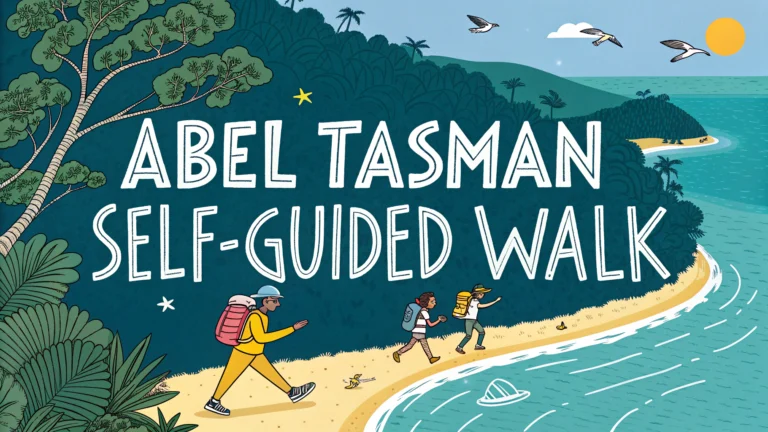The Abel Tasman Coast Track stands as one of New Zealand’s most scenic multi-day walks, stretching 60 kilometers along the stunning coastline of Abel Tasman National Park.
Quick Facts About the Track
- Length: 60 km (37 miles)
- Duration: 3-5 days
- Difficulty: Easy to moderate
- Best season: October to April
- Location: Top of New Zealand’s South Island
Track Sections
| Section | Distance | Walking Time |
|---|---|---|
| Marahau to Anchorage | 12.4 km | 4 hours |
| Anchorage to Bark Bay | 8.4 km | 3 hours |
| Bark Bay to Awaroa | 13.5 km | 4.5 hours |
| Awaroa to Whariwharangi | 13.5 km | 5 hours |
| Whariwharangi to Wainui | 5.7 km | 2 hours |
Planning Tips
- Book accommodation in advance – huts and campsites fill up quickly during peak season
- Check tide times – some sections require low tide crossings
- Water taxi services – available for track access and shortcuts
- Pack light – bring only essential gear as you’ll carry everything
Essential Gear
- Walking shoes or boots
- Rain jacket
- Sun protection
- First aid kit
- Water bottle
- Map and track guide
- Camera
Transport Options
Several operators provide transport services to and from track endpoints:
- Abel Tasman Water Taxis: +64 3 527 8083
- Marahau Water Taxis: +64 3 527 8176
- Trek Express: +64 3 528 7628
Accommodation Booking
Book DOC huts and campsites through the Department of Conservation website: https://booking.doc.govt.nz
Weather Considerations
The Abel Tasman area experiences mild temperatures year-round, but proper preparation remains important.
Average Temperatures
- Summer (Dec-Feb): 20-25°C
- Winter (Jun-Aug): 12-16°C
Check current track conditions and weather forecasts at the DOC visitor center in Marahau before starting your walk.
Track Features
- Golden sand beaches
- Native forest sections
- Coastal viewpoints
- Marine wildlife spotting
- Historical Māori sites
- Crystal-clear waters
Wildlife Encounters
The track offers opportunities to spot diverse wildlife including:
- New Zealand fur seals
- Dolphins
- Native birds (Tui, Bellbird, Weka)
- Little Blue Penguins
Side Trips
- Cleopatra’s Pool – natural rock pools
- Separation Point – seal colony
- Falls River suspension bridge
- Coastal lookout points
Track Etiquette
- Stay on marked tracks
- Pack out all rubbish
- Respect wildlife – maintain distance
- Follow hut and camping regulations
- Give way to uphill walkers
Conclusion
The Abel Tasman Coast Track offers a perfect blend of coastal scenery, native forests, and wildlife encounters. With proper planning and preparation, walkers of various fitness levels can enjoy this iconic New Zealand experience. The track’s well-maintained facilities and flexible transport options make it an ideal choice for both first-time and experienced hikers.
Remember to book accommodation well in advance, check weather conditions, and respect the natural environment to ensure an enjoyable and sustainable hiking experience.
FAQs
- How long is the Abel Tasman Coast Track self-guided walk?
The complete track is 60 kilometers (37 miles) long, typically taking 3-5 days to complete when walking the entire length from Marahau to Wainui Bay. - Do I need to book huts and campsites in advance?
Yes, you must book all Department of Conservation (DOC) huts and campsites in advance, especially during peak season (December-March), as the track is extremely popular. - What’s the best time of year to do the Abel Tasman self-guided walk?
The best time is during New Zealand’s summer months (December to February) when weather is most stable, though spring (October-November) and autumn (March-April) also offer pleasant walking conditions with fewer crowds. - Can I do sections of the track as day walks?
Yes, water taxis operate along the coast, allowing walkers to access different sections of the track for day walks and return trips. - What fitness level is required for the track?
The track is rated easy to moderate, with well-formed paths and gentle climbs. Most people with average fitness can complete the walk comfortably. - What essential items should I pack for the walk?
Essential items include water, proper hiking boots, rain jacket, sunscreen, insect repellent, first aid kit, and sufficient food for your journey. A sleeping bag is required if staying in huts. - Are there water sources along the track?
Water is available at all DOC huts and most campsites, but it’s recommended to treat all water before drinking. Some beaches and sections have no water access. - Is it possible to swim during the walk?
Yes, there are numerous beautiful beaches along the track where you can swim. The best swimming spots include Anchorage, Torrent Bay, and Bark Bay. - How do I handle tidal crossings on the track?
There are two major tidal crossings at Awaroa Inlet and Torrent Bay. Check tide timetables and plan your walking schedule around low tide, or use the all-tide track alternatives. - Are there places to buy supplies along the track?
No permanent shops exist along the track. You must carry all necessary supplies, though some lodges may offer limited supplies during peak season. Marahau and Kaiteriteri have shops before the track starts.








